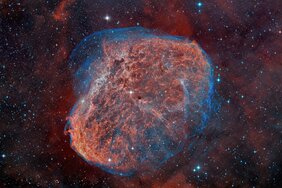Scientists from the University of Heidelberg, the Instituto de Astrofísica de Canarias (IAC) and the Universidad Nacional Autónoma de México (UNAM) propose a solution to the abundance discrepancy in star-forming regions, an astrophysical problem with more than 80 years of history that called our knowledge of the chemical evolution of the universe into question. They identify the presence of temperature inhomogeneities in the nebular gas, causing a systematic underestimation of the heavy element abundances. This important finding has now been published in Nature, one of the most prestigious scientific journals in the world.
In the history of the universe, chemical elements formed in two fundamental phases. First, the elements deuterium, helium and lithium were formed immediately after the Big Bang. Since then, as the universe continued to expand and cool, stars were formed in which chemical elements such as oxygen and nitrogen were produced. Collisions of neutron stars or supernova explosions created even heavier elements like silver or gold.
Some of these elements remain trapped in long-lived stars or their remnants, or are released by supernova explosions and stellar winds. In interstellar space, they are then available to subsequent generations of stars as their building material. The changes and spatial variations in the abundance of chemical elements since the Big Bang reveal much about the evolution of galactic structures and are therefore intensively studied.
Gas clouds surrounded by very massive stars, known as HII regions, emit a large amount of radiation, which is possible to observe even at the greatest cosmic distances, when the universe was still young. By studying their emission lines, fundamental components of the observed light, it is possible to derive their chemical composition. Some of these lines are produced by collisions between heavy atoms and free electrons while others are produced by electron recombinations.
Although the measurement of elemental abundances has made considerable progress in recent decades, a major problem remained: since the 1940s we know that recombination lines systematically provide about twice the abundance of heavy elements than their collisionally excited counterparts. Which of the abundances, if any, is the correct one?
In 1967, Manuel Peimbert, one of the co-authors of the article, proposed that an inhomogeneous temperature in the HII regions could cause the observed abundance discrepancy. In such scenario, the hottest areas would amplify the emission of collisionally excited lines. As a result, the temperature estimated from these lines would be higher than the actual average value, introducing in turn an underestimation of the chemical abundances. In contrast, recombination lines would not be affected by the temperature variations, given their low dependence on this parameter. Under this paradigm, recombination lines would provide the correct chemical abundances. However, they are 10.000 times weaker than the bright collisionally excited lines. Therefore, the lack of widely accepted evidence of the presence of temperature inhomogeneities in the HII regions has inhibited the standard use of recombination lines to derive chemical abundances.
To find a way out of this dilemma, the first author of the article, José Eduardo Méndez-Delgado, propose that the temperature variations in the HII regions could be concentrated in the areas closest to the most massive stars, more irradiated and therefore more highly ionized. If there is any inhomogeneous heating due to stellar feedback phenomena (such as shocks or winds or brightness variations), the most affected area will be the one closest to the stars. In this case, the temperature difference between the areas with high and low degree of ionization should be related with the parameter that quantifies the abundance discrepancy. Surprisingly, all the available observations of HII regions follow the predicted trend. “It is the first time that a general solution to this problem is supported by such strong evidence” adds the scientist, who conducts research at the Astronomical Computing Institute (ARI) of the Center for Astronomy at Heidelberg University.
In fact, Méndez-Delgado and his colleagues found in their analysis that it is possible to derive the correct chemical abundances by using the collisional excited lines of low ionization ions, such as the nitrogen once ionized, which can solve the problem of the faintness of the recombination lines. "The circumstantial evidence required for this result was already all available in databases. Like Sherlock Homes, we just had to look at it from the right perspective," adds the astrophysicist.
Dr. Kathryn Kreckel, Emmy Noether Research Group Leader at the Astronomisches RechenInstitut and also a co-author of the paper, estimate that many conclusions on the chemical composition and evolution of galactic system may change, as they are based on collisionally excited lines that underestimate the abundance of heavy elements. "Our results suggest that temperature inhomogeneities may be particularly large for less evolved objects in the universe, such as the distant and young galaxies we detect with the James Webb Space Telescope (JWST). There are still many things to unravel on this matter, making it an even more exciting result. " adds Kreckel, in whose research group Dr. Méndez-Delgado is a member.
ORIGINAL PUBLICATION
Temperature inhomogeneities cause the abundance discrepancy in HII regions, J. Eduardo Méndez Delgado et al, NATURE, doi.org/10.1038/s41586-023-05956-2
SCIENTIFIC CONTACT
Dr. José Eduardo Méndez Delgado
Center for Astronomy of Heidelberg University
Astronomisches Rechen-Institut
E-mail: jemd@uni-heidelberg.de
CONTACT FOR THE MEDIA
Dr. Guido Thimm
Center for Astronomy at Heidelberg University
thimm@uni-heidelberg.de

